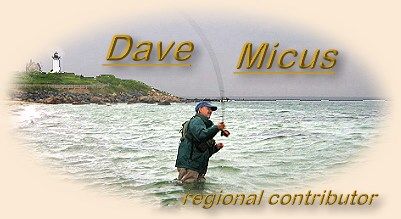|
I don't go trouting much. I have striped bass
fishery literally right out my front door, and
the trout fishing in my corner of Massachusetts
is so dismal I didn't even bother to purchase a
license this year. But I'll still go on a trouting
trip when the opportunity arises, and such was the
case when I was invited to New Hampshire to fish
the Androscoggin River with my good friend Dick
Brisbois.
Dick is a retired Massachusetts state trooper who
lived in a neighboring town but moved to the White
Mountains of New Hampshire when he hung up the gun
and badge a few years back. In his later years
with the state police he was a crime scene investigator,
and bearing witness to just how bad things can be
has made him appreciate the outdoors and, especially,
fishing all the more. Dick is the quintessential
Yankee; a stoic fašade that encases a kind soul,
and it would be difficult to imagine a better friend.
I usually fish the brine, and I feel comfortable
saying that salt-water fishing is the antithesis
of trout fishing. Almost everything about the two
is opposite. The equipment for the salt is twice
the size-9 or 10 wt. rods compared to 4 or 5; 20
lb. straight leader compared to 2 pound graduated
tippet; and size 2/0 salt-water streamers that could
eat the delicate size 18 dry flies. The technique
varies too; 80, 90, 100 ft. casts compared to 20,
30 or 40 footers; splashy presentations with rapidly
stripped streamers opposed to delicate presentations,
line mending, and dead drifting; ferocious strip
strikes instead of gently raising the rod. Striped
Bass fishing is the mosh pit; trout fishing, ballet.
That's not to say that I don't enjoy fishing for
trout. Streamside on a gently flowing river casting
a light fast rod to rising fish can be a welcome
relief to being pounded by the surf while blind
fishing a ten weight on a beach at 4 am. And,
though I'm hesitant to admit it, it usually requires
more skill to fool a ten-inch trout than it does to
trick a three-foot bass. The first thing I need to
do when trout fishing is to forget everything I know
about the salt. This takes time, and I'll usually
double haul a few 60-foot casts into the trees on
the other side of a 30 ft. wide stream, use the water
to load the rod on the false cast and scare every
trout within 50 yards, and set the hook so hard
as to sentence an 8 inch brookie to death by hanging
in a tree behind me before I settle down to the Zen
of trout fishing.
And then there's the river itself. The Androscoggin
is an enigma, and the larger fish are weary and well
hidden. Conventional wisdom suggests there are no
fish below the paper mills that line the bank of the
Androscoggin, the pollution being such that nothing
would survive. Yet recently it's been discovered that
there are many big trout below the mills; which left
unmolested by fishermen they learned to adapt to the
river and grew to trophy size. And while there are
pockets and riffles and runs and bend pools and
everything else where the trout should be, they
usually aren't. The Androscoggin is a puzzle that
needs to be solved.
We moved down river, Dick out-fishing me as he always
does in freshwater, enjoying the day, each other's
company, and the occasional moose that would wander
down to feed on the vegetation at the water's edge.
It was while admiring such a moose that I saw it,
the larger ring of a rhythmically feeding trout
whose surface splashes hinted he was a good bit
bigger than the fish I'd been taking. I approached
from upstream and cast a nymph quartering and
downstream, mended the line, then followed the
drift with the rod tip, steering the nymph into
the trout's feeding lane. My offer was refused.
I tried again, and then again; still no dice.
The trout kept feeding, but not on the #14 prince
nymph I offered.
"It's not fly fishing if you're not looking for
answers to questions," wrote Norman Maclean, and
sometimes these questions are forays into
epistemological dilemmas that have confronted
man since he first crawled from the primordial
swamp. Other times, like now, they concern a
problem at hand. A trout stream is a great place
to solve problems both great and small. So I
analyzed the moment. My presentation did not
spook the fish, a plus. The fish wasn't interested
in the nymph, a minus. The question was basic:
what is this particular trout feeding on, and
how do I imitate it?
In an extreme lapse of character, I calmly watched
(instead of whipping the stream into meringue which
is my usual m.o.), and, just barely visible as it
rose off the water, I saw it; a tiny, pale insect,
(Latin: Smallus Whitus Insectus). Here was my
answer. I lengthened the 9-foot 5x leader to 12
feet by tying on three feet of 6x tippet with a
barrel knot using knowledge from a distant past
that I didn't even realize I still possessed. I
tied on a light colored sized 20 dry fly, smaller
than the eyes on my saltwater streamers, false cast
once, and placed the fly right in the trout's feeding
lane. The drift was perfect, the imitation precise,
and the trout rose and took the fly. I raised the
rod to set the hook, felt the weight of a good-sized
fish on for a second, and then the line went limp.
I usually don't go for esoteric descriptions of
fly-fishing. It isn't, after all, religion, nor
philosophy, and if you compare it to sex, as the
saying goes, you're doing one of them wrong. But
I agree with John Gierach's observation that
fly-fishing "is maybe the only place where the
possibility of rightness even exists." Such was
the case here: right fly; right cast; right drift;
wrong strike. And, on a trout stream in the New
Hampshire woods fishing with a dear friend, that's
close enough for me. ~ Dave
About Dave:
 Dave Micus lives in Ipswich, Massachusetts. He is an
avid striped bass fly fisherman, writer and instructor.
He writes a fly fishing column for the Port City Planet
newspaper of Newburyport, MA (home of Plum Island and Joppa Flats)
and teaches a fly fishing course at Boston University.
Dave Micus lives in Ipswich, Massachusetts. He is an
avid striped bass fly fisherman, writer and instructor.
He writes a fly fishing column for the Port City Planet
newspaper of Newburyport, MA (home of Plum Island and Joppa Flats)
and teaches a fly fishing course at Boston University.
|



